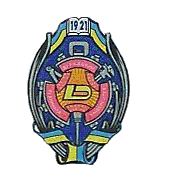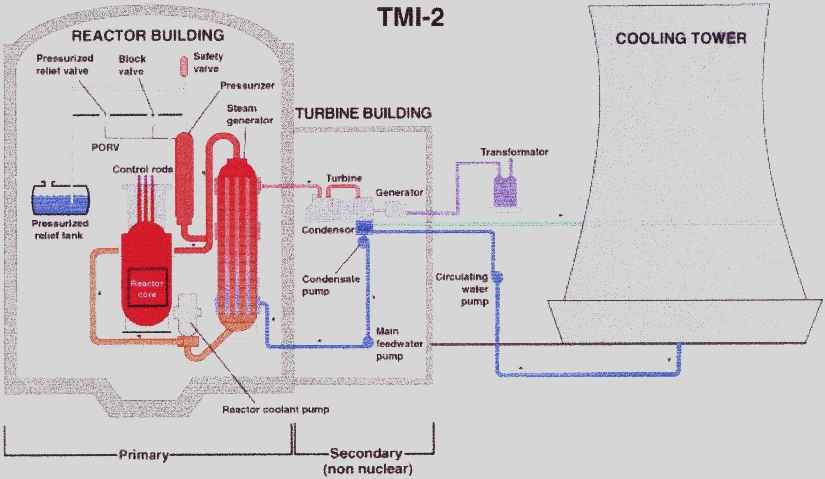


 |
 |
 |
| Автобиография | Индивидуальное задание | Библиотека | Ссылки | Результат поиска |
| Abstract on a theme: "Influence of the human factor on maintenance of reliability and safety of technical object" |
 |

|
Urgency of a problem. As a result of failure on an atomic power station more people can be killed, than at the explosion of a nuclear bomb. Consequences in the financial attitude can be also catastrophic. The accident in 1986 in the Chernobyl atomic power station cost the former Soviet Union in three times more, than the total economic benefit which has been saved up as a result of work of all Soviet atomic power stations, maintained in 1954-1990. It is known, that on March, 28th, 1979 at 4 o'clock in the morning on local time for American atomic power station " Three-mail-Island" on reactor PWR (the choke with water under pressure) capacity 885 МW the generating set №2 the accident was happened. As a result of the accident the top hamper of active zone of the reactor then its restoration became inexpedient was melted. The general damage from the accident made 1,86 billion dollars [2]. In Ukraine 13 generating sets with chokes of type VVER an installed capacity 11,8 GW work now. The majority of blocks VVER have been in the operation for more than 15 years (design service life-30 years). The significant part electrotechnical and heattechnical the equipment of the atomic power station (2000 - 5000 units) requires replacements because term of their operation expires[3]. The fourth block of the Chernobyl atomic power station was entered in build in 1983, and the accident in it happened in 1986, practically at the new station. There is a lawful question, whether similar explosion and on other atomic power stations of the Ukraine which has worked more of half of the design term is it possible? What is the probability of display of large accidents on the working atomic power stations? What is the probability of what there will be a an accident on the atomic power station and a radioactive cloud will pass above Europe? There are no answers to these questions. Techniques known to us now [4-7] do not allow with sufficient for practical purposes a degree of accuracy to estimate probability of accidents occurrence on the atomic power station, and it in turn does not give an opportunity to use existing and to develop the new technical and organizational actions, allowing to reduce frequency of accidents occurrence to the normalized level. The further development of mathematical models and techniques of process estimation of accidents formation, for example, fusion of active zone of the choke on the atomic power station which allow to establish dependences of probability of accident occurrence on a running time of station, conditions of the maintaining equipment, the environment (people) surrounding it, reliability of means of protection (reacting to emergency changes of electric and technological parameters of object) and terms of their preventive maintenance, is rather actual scientific task. Therefore the works connected with development of mathematical models and perfection of existing techniques which allow to a level of safety of the atomic power station, and also development of organizational and technical actions that allows to provide normalized with the international norms of levels of safety with the minimal expenses is rather actual. The purpose of work. Using concepts Marks of casual processes with discrete number of conditions and continuous time is to estimate probability of fusion of active zone of the choke within a year F1 (t), to define average time before accident and a dispersion provided that during the initial moment of time all safety systems of the atomic power station were in an operable state. For achievement of the object in view it is necessary: 1. To study a principle of construction of protection which provides safety on the atomic power station; 2. To study a principle of action of the protection interfering process of fusion of active zone of the reactor; 3. To study possible scripts of accidents occurrence on the atomic power station, accompanied the core disruption of the reactor; 4. To develop mathematical model of process of formation of core-melt accident of the reactor; 5. To give an example of accounts of probability of fusion of active zone of the reactor. Scientific importance of work. Offered in masters work the technique will allow: - To estimate probability of fusion of active zone of the reactor within a year and to compare it to the normalized level; - To define average time before accident and a dispersion of time before the first accident; - To set norms to reliability (manufacturers) with support of protection and optimum from the point of view of safety terms of their marginal checking at which the normalized level of safety on the atomic power station is provided
( Results of researches In process of perfection of control systems by nuclear reactors transition to new element base (the microprocessors, operated computers), reliability of these systems increases, however number of refusals in system grows in connection with increase in number of mistakes of the person - the operator. According to work [8], human error is any concrete action of the person during his activity which leaves for some admissible borders, exceeds the admission which borders are certain by modes of system operation. This inadequate perception of the so information, incorrect decisions, inexact teams or the wrong actions of the personnel initiating events, lead to deviations from a mode of normal operation. The mistake of the person is defined as default of a task in view (or performance of the forbidden action) which can be the reason of damage of the equipment or property or infringement of a normal course of the planned operations. There are also deliberate mistakes when the person performs work incorrectly charged to him, regarding it as correctly executed. The cases of wrecking entailing accidents or accidents, in the given context are not considered as a mistake. It is possible to confirm, that there where the person works, the mistakes appear. They arise irrespective of the preparation level, qualification or experience. Therefore the reliability prediction of the equipment without taking into account reliability of work of the person cannot give a true picture. Mistakes on fault of the person can arise when: - The operator or any person aspires to achievement of the erroneous purpose; - The object in view cannot be achieved because of wrong actions of the operator; - The operator stays idle during that moment when his participation is necessary. Not all mistakes of the person conduct all to accidents in system. The mistake can be corrected before will render undesirable influence on system. It is possible in the event that, for example, work of the operator continuously or through certain time is supervised by other operator. Or the system is capable to erase a mistake admitted by the person.Hence, the mistake of the person can be characterized frequency of its occurrence and duration of existence. In work [9] reliability of the person is certain as follows: «Probability, that work or a task will be successfully performed by the personnel at any required level of system work during a required time interval (if there is a restriction on time)». Reliability of the person work is defined as probability of successful performance by him of work or tasks in view at the set stage of functioning of system during the time set space at the certain requirements to duration of work performance. In the given work as reliability of the person we shall understand it probability of that during time t the person will not make any mistake. Let space of times between occurrences of mistakes of the person and duration of a mistake does not contradict exponential to distribution function of probabilities then probability of that the person will make a mistake during time t we shall define as follows:
where n - number of the person mistakes; Distribution function of duration of a mistake:
where m - number of the space of times describing mistakes duration. In department EPG the technique which allows to define for any person Literature 1. Швыряев Ю.В. и др. Вероятностный анализ безопасности атомных станций. Методика выполнения. - М.: ИАЭ им. И.В.Курчатова, 1992. - 265 с. 2. Новиков И.И., Кружилин Г.Н. Уроки аварии реактора PWR на АЭС Три-Майл-Айленд в США в 1979 г. – Электрические станции, 1999, №6, с.29-35. 3. Концепція державної енергетичної політики України на період до 2020 року. Центр Розумкова. Національна безпека i оборона, 2001. - №2, с.2-33. 4. Швыряев Ю.В. Вероятностный анализ безопасности атомных станций. Методика выполнения. - М.: ИАЭ им. Курчатова, 1992. 5. Руководство по проведению вероятностного анализа безопасности атомных станций: Отчет. - М.: МАГАТЭ, 1990. 6. Вероятностный анализ безопасности атомных станций: Учебное пособие/ В.В. Бегун, О.В.Горбунов, И.Н. Каденко и др. - К., 2000 - 568 с. 7. Ваганов П.А. Ядерный риск: Учеб. пособие – СПб.: изд-во С-Петербург, ун-та, 1997 – 112 с. 8. Evans R. A. (1976) Reliability optimization. In E. J. Henly, J. W. Lynn, edc, Generic techniques in systems reliability assessment. Leyden, The Netherlands: Noodhoff International Publishing, pp. 117-131. 9. Swain A. D., Guttmann H. E. (1983, August) handook of human reliability analysis with emphasis on nuclear power plant application (Sandia National Laboratories, NUREG/CR-1278) Washington, DC: U. S. Nuclear Regulatory Commission. 10. Бабаев Н.С., Кузьмин И.И., Легасов В.А., Сидоренко В.А. Проблемы безопасности на атомных электростанциях// Природа. – 1980 – №6 – С. 30-43. 11. Тиханов В.И., Миронов в.А. Марковские процессы.- М.: Советское радио, 1977 – 320 с. 12. Ковалев А. П., Муха В. П., Джура С. Г., Якимишина В. В., Зрадовская О. Я. О математическом моделировании аварии, происшедшей с реактором PRW на АЭС Три-Майл-Айленд в США в 1978 г. Наукові праці ДонНТУ - Електротехніка і енергетика – 2006 - випуск 112 с. 122-125. 13. А.Ф. Бергмант, И.Г. Араманович. Краткий курс математического анализа. – М.: Наука, 1966 – 735 с. 14. Кемени Дж., Скел Дж. Конечные цепи Маркова. – М.: Наука, 1970. – 110 с. 15. Ковалев А.П. О проблемах оценки безопасности электротехнических объектов// Электричество. – 1991-№7. – С. 50-55. |
| Автобиография | Индивидуальное задание | Библиотека | Ссылки | Результат поиска |